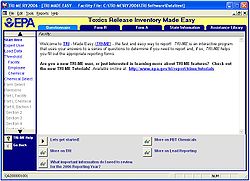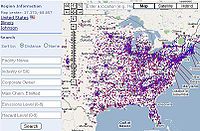
Toxics Release Inventory
Encyclopedia

Waste management
Waste management is the collection, transport, processing or disposal,managing and monitoring of waste materials. The term usually relates to materials produced by human activity, and the process is generally undertaken to reduce their effect on health, the environment or aesthetics...
activities in the United States
United States
The United States of America is a federal constitutional republic comprising fifty states and a federal district...
.
Summary of requirements
The database is available from the United States Environmental Protection AgencyUnited States Environmental Protection Agency
The U.S. Environmental Protection Agency is an agency of the federal government of the United States charged with protecting human health and the environment, by writing and enforcing regulations based on laws passed by Congress...
(EPA) and contains information reported annually by certain industry groups as well as federal
Federal government of the United States
The federal government of the United States is the national government of the constitutional republic of fifty states that is the United States of America. The federal government comprises three distinct branches of government: a legislative, an executive and a judiciary. These branches and...
facilities. Each year, companies across a wide range of industries (including chemical, mining, paper, oil and gas industries) that produce more than 25,000 pounds or handle more than 10,000 pounds of a listed toxic chemical must report it to the TRI. The TRI threshold was initially set at 75,000 pounds annually. If the company treats, recycles, disposes, or releases more than 500 pounds of that chemical into the environment (as opposed to just handling it), then they must provide a detailed inventory of that chemical's inventory.
Origins of TRI
The inventory was first proposed in a 1985 New York Times op-ed piece written by David Sarokin and Warren Muir, researchers for an environmental group, INFORM. CongressUnited States Congress
The United States Congress is the bicameral legislature of the federal government of the United States, consisting of the Senate and the House of Representatives. The Congress meets in the United States Capitol in Washington, D.C....
established TRI under the Emergency Planning and Community Right-to-Know Act
Emergency Planning and Community Right-to-Know Act
The Emergency Planning and Community Right-to-Know Act of 1986 is a United States federal law passed by the 99th United States Congress located at Title 42, Chapter 116 of the U.S. Code, concerned with emergency response preparedness....
of 1986 (EPCRA), and later expanded it in the Pollution Prevention Act of 1990. The law grew out of concern surrounding Union Carbide's
Union Carbide
Union Carbide Corporation is a wholly owned subsidiary of The Dow Chemical Company. It currently employs more than 2,400 people. Union Carbide primarily produces chemicals and polymers that undergo one or more further conversions by customers before reaching consumers. Some are high-volume...
releases of toxic gases in the 1984 Bhopal disaster
Bhopal disaster
The Bhopal disaster also known as Bhopal Gas Tragedy was a gas leak incident in India, considered one of the world's worst industrial catastrophes. It occurred on the night of December 2–3, 1984 at the Union Carbide India Limited pesticide plant in Bhopal, Madhya Pradesh, India...
and a smaller 1985 release in Institute, West Virginia
Institute, West Virginia
Institute is an unincorporated community on the Kanawha River in Kanawha County, West Virginia, USA. The community lies off of Interstate 64 and West Virginia Route 25, and has grown to intermingle with nearby Dunbar...
.
Revisions to reporting requirements
Proposed changes in late 2005 would have lowered the reporting standards for the TRI program. Several state attorney generalAttorney General
In most common law jurisdictions, the attorney general, or attorney-general, is the main legal advisor to the government, and in some jurisdictions he or she may also have executive responsibility for law enforcement or responsibility for public prosecutions.The term is used to refer to any person...
s wrote to EPA asking that the standard not be altered. The proposed revisions came under fire from Eliot Spitzer
Eliot Spitzer
Eliot Laurence Spitzer is an American lawyer, former Democratic Party politician, and political commentator. He was the co-host of In the Arena, a talk-show and punditry forum broadcast on CNN until CNN cancelled his show in July of 2011...
, then the Attorney General for New York, who said "Public disclosure has proven to be a strong incentive for polluters to reduce their use of toxic chemicals, this move by EPA appears to be yet another poorly considered notion to appease a few polluting constituents at the expense of a valuable program." EPA originally proposed to reduce the required reporting frequency from every year to every other year. This drew intense criticism, and the idea was dropped.
However, EPA went forward with another part of the plan that initially did not receive much attention. Companies were previously required to disclose any release over 2000 pounds (907 kg) on a more detailed "Form R" rather than the less detailed "Form A." With the new regulations, the minimum reporting requirements for Form R have been increased to 5000 pounds (2268 kg), thus reducing the amount of information available. Although this move was widely criticized by the public as well as many officials, EPA went ahead with the new rule anyway. EPA claimed that the comments submitted opposed to the Form R requirements were invalid because nearly all the people who had commented did so on both the change in reporting frequency as well as the minimum amounts required for Form R.
Accessing TRI data
The data in the Toxic Release Inventory is available to the public, but initially the system was difficult to access. In recent years, EPA and several other organizations have made the task much easier.Mapping Systems
There are several tools for mapping the TRI data to particular locations. These tools also allow the user to view some of the information in the database.
- TOXMAPTOXMAPTOXMAP is a geographic information system from the United States National Library of Medicine that uses maps of the United States to help users visually explore data from the United States Environmental Protection Agency's Toxics Release Inventory and Superfund programs...
is a Geographic Information System (GIS) from the Division of Specialized Information Services http://sis.nlm.nih.gov of the United States National Library of MedicineUnited States National Library of MedicineThe United States National Library of Medicine , operated by the United States federal government, is the world's largest medical library. Located in Bethesda, Maryland, the NLM is a division of the National Institutes of Health...
(NLM) that uses maps of the United States to help users visually explore data from the United States Environmental Protection AgencyUnited States Environmental Protection AgencyThe U.S. Environmental Protection Agency is an agency of the federal government of the United States charged with protecting human health and the environment, by writing and enforcing regulations based on laws passed by Congress...
's (EPA) Toxics Release Inventory and Superfund Basic Research ProgramSuperfund Basic Research ProgramThe Superfund Research Program was created within the National Institute of Environmental Health Sciences in 1986 under the Superfund Amendments and Reauthorization Act...
s. TOXMAP is a resource funded by the US Federal Government. TOXMAP's chemical and environmental health information is taken from NLM's Toxicology Data Network (TOXNET) http://toxnet.nlm.nih.gov and PubMedPubMedPubMed is a free database accessing primarily the MEDLINE database of references and abstracts on life sciences and biomedical topics. The United States National Library of Medicine at the National Institutes of Health maintains the database as part of the Entrez information retrieval system...
, and from other authoritative sources.

- MapEcos.org is a browser-based tool. It allows users to access an interactive map of the US showing the most recent TRI data. The map can be searched for locations of interest. At lower zoom levels, it allows the user to get information on pollution from particular facilities. This site was created by faculty and students at Dartmouth CollegeDartmouth CollegeDartmouth College is a private, Ivy League university in Hanover, New Hampshire, United States. The institution comprises a liberal arts college, Dartmouth Medical School, Thayer School of Engineering, and the Tuck School of Business, as well as 19 graduate programs in the arts and sciences...
, Harvard Business SchoolHarvard Business SchoolHarvard Business School is the graduate business school of Harvard University in Boston, Massachusetts, United States and is widely recognized as one of the top business schools in the world. The school offers the world's largest full-time MBA program, doctoral programs, and many executive...
, and Duke UniversityDuke UniversityDuke University is a private research university located in Durham, North Carolina, United States. Founded by Methodists and Quakers in the present day town of Trinity in 1838, the school moved to Durham in 1892. In 1924, tobacco industrialist James B...
. - The Commission for Environmental Cooperation has created a downloadable File for Google Earth which shows all of the most recent reports to the TRI database. It also includes locations from the equivalent Canadian and Mexican pollution inventory. The system currently only maps the locations and links to data at the national registries.
- DotGovWatch offers a simple browser-based map of TRI data. The map can be searched by city, address, and each facility's detailed emissions are available.
- TRI.NET is a new application developed by EPA that supports complex adhoc queries of TRI data. TRI.NET maps facilities using Google Maps, Google Earth, or Virtual Earth. Additional data layers allow TRI data to be analyzed with respect to other factors such as Environmental Justice, Chemical Toxicity, and Tribal and U.S. Mexico Border geographies. Uses powerful drill-downs and advanced trends to spot trends and hot spots.
Public Portals
- Scorecard.org For those seeking detailed information, the easiest access to the data is at scorecard.org. This site also provides information about a variety of other pollution issues, but it has not been updated since 2002. This site was created by a team at Environmental DefenseEnvironmental DefenseEnvironmental Defense Fund or EDF is a United States–based nonprofit environmental advocacy group. The group is known for its work on issues including global warming, ecosystem restoration, oceans, and human health...
. It is now run by the Green Media Tool Shed.
Research Oriented Portals
- RTKnet.org Run by an OMB watch, this site provides access to current to a variety of EPA data, including data for the TRI. Queries allow users to download files with the raw data.
- The EPA also provides access to the raw data through their Envirofacts site. As with RTK net, queries to the underlying relational database produce downloadable text documents.
External links
- EPA's TRI.NET page (for accessing the data)
- EPA's TRI Explorer page (for accessing the data)
- The Right-to-Know Network for accessing the TRI
- Environmental Working Group's report on the TRI rollback
- OMB Watch's page on the TRI
- National Environmental Trust's Page on the TRI
- TOXMAP: National Institute of Health's Environmental Health e-map

